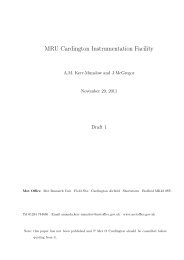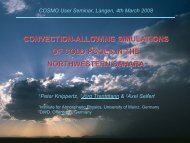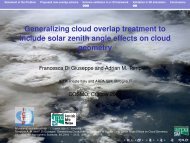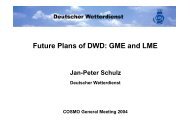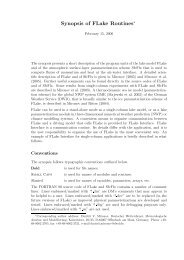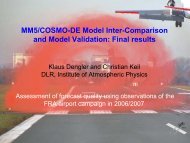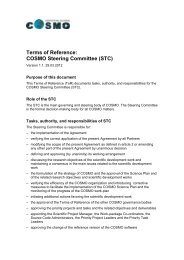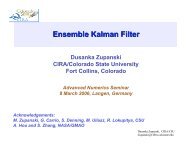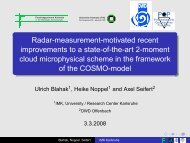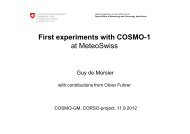document - Cosmo
document - Cosmo
document - Cosmo
You also want an ePaper? Increase the reach of your titles
YUMPU automatically turns print PDFs into web optimized ePapers that Google loves.
1 Working Group on Data Assimilation 19<br />
Figure 5: Scatter plot of BT3.9 − BT13.4 against BT3.9 − BT10.8 for the same scene<br />
as shown in Fig. 3.<br />
4.3 Classification method<br />
In remote sensing of snow cover, often threshold based classification trees are used. The<br />
spectral properties of clouds and snow are well known, which makes it straight-forward<br />
to choose threshold tests and to set values for the thresholds. This classification method<br />
generally gives good results and is easy to implement. Here we choose another standard<br />
classification method, namely maximum likelihood classification. With this method each<br />
pixel is assigned to the class for which the conditional probability of the pixel is highest.<br />
The advantage of this method is that it can adequately classify pixel distributions like the<br />
one shown in Fig. 5. Also, maximum likelihood classification gives probabilities in stead of<br />
rigid values (e.g. snow or cloud), which can be used for assigning quality flags to the pixels.<br />
When we assume that the features are normally distributed, the conditional Probability Density<br />
Functions (PDFs) are given by the multi-variate normal distribution. For each images<br />
class, this distribution is described be the mean feature values and the feature covariance<br />
matrix. We chose four classes to which pixels can be assigned: snow-free land, snow, ice<br />
clouds and water clouds. Although we are not interested here in distinguishing between<br />
different cloud types, we do make the division between ice clouds and water clouds in order<br />
to improve the separation of clear and cloudy pixels. Clouds containing ice particles differ<br />
in appearance from water clouds in several ways: r1.6, BT3.9 − BT10.8 and BT3.9 − BT13.4<br />
are lower (see Fig. 3 and 5) when ice particles are present. There is also a difference in mean<br />
temporal variability between ice clouds and water clouds (Fig. 3). A simple threshold of for<br />
r1.6 is used for differentiating between training areas for ice clouds and water clouds.<br />
In order to determine for all classes the means of the features and the covariance matrices, we<br />
first classified all images with a simple threshold-based classification using only the spectral<br />
features. The values of the thresholds were chosen such that the best classification results<br />
were obtained, as could be subjectively judge by visual inspection. For the threshold-based<br />
classification we use a simple scheme that includes the ratio between BT3.9 − BT10.8 and<br />
BT3.9 − BT13.4, which we found very suitable for detecting clouds (Fig. 4c). Pixels that are<br />
not classified as cloudy in this way, are checked for the presence of snow by a second suite<br />
of tests.<br />
The threshold-based classification missed some clouds that were misinterpreted as snow, but<br />
COSMO Newsletter No. 6




